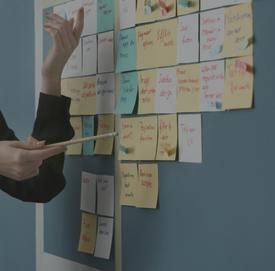BLOG

User Stories for Agile Development: A Guide to Meeting User Needs
Agile software development relies heavily on the use of user stories to ensure that software development projects meet the needs of end-users. User stories are a way of capturing what a user needs to do with the software, in a simple and concise way. Writing excellent user stories requires practice and intentionality.
What is a user story for Agile?
An Agile user story is defined as a concise and simple description of a feature or functionality of a software application that highlights the user, their goal, and the reason for achieving that goal. Typically written from the end user’s perspective by the product owner, the user story communicates requirements to the development team. User stories are meant to be short, specific, and easy to understand, helping to ensure that the development team can deliver features that meet the needs of the end users.
When developers first start writing user stories, they often stick to a common user story template of “As a [type of user], I want to [goal], so that [reason or benefit].”
Here’s an example of a good user story for a website that is looking to streamline the way travelers make reservations for trips:
“As a frequent traveler, I want to be able to view my upcoming flights and hotel reservations in one place, so that I can easily keep track of my travel plans and make changes as needed.”
Why is a user story important?
User stories keep the agile teams focused on what truly matters: the users’ experience with the application. Although user stories are concise, they are the launch point that facilitates communication between stakeholders and the development team.
After reviewing the user stories as a team, they will start to map out the work that is involved to meet the user’s needs. This can often include discussions and tasks around UX design, backend technology, front-end component libraries, and user testing strategies.
5 Things to Remember When Writing User Stories
Keep it simple
User stories should be simple and easy to understand. They should be written in a way that anyone on the development team can understand, regardless of their technical expertise. Use clear, concise language that avoids technical jargon, so that everyone is on the same page.
Define user personas
Defining user personas helps to create user stories that are focused and specific. User personas are fictional characters that represent the different types of users who will use the software. Each persona should have a unique set of characteristics, such as goals, challenges, and preferences, that can be used to create targeted user stories.
Focus on user needs
User stories should focus on the needs of the users, rather than the features of the software. A user story should describe what the user needs to do, not how the software will achieve that goal. For example, a user story might be: “As a sales manager, I need to be able to view my team’s sales reports, so that I can track their progress and identify areas for improvement.”
Involve the end-users
How do you know you’re focused on what the user needs? Involve them. End-users are the people who will be using the software, and they have a practical understanding of what they need from it. Collaborating with end-users helps to create user stories that accurately reflect the needs of the users.
Include acceptance criteria
Acceptance criteria define the conditions that must be met for a user story to be considered complete. Acceptance criteria helps to ensure that the development team and the end-users have a clear understanding of what is required. Acceptance criteria can be written in the form of user scenarios that define how the software should behave when a user interacts with it.
YOU MAY ALSO LIKE

April 7, 2023 - Jon A.
Software Development Agile Spikes: Investigating Solutions Mid-Sprint

February 21, 2023 - Jon A.
What is a Scrum Master & How They Can Help Your Team Reach Its Goals


